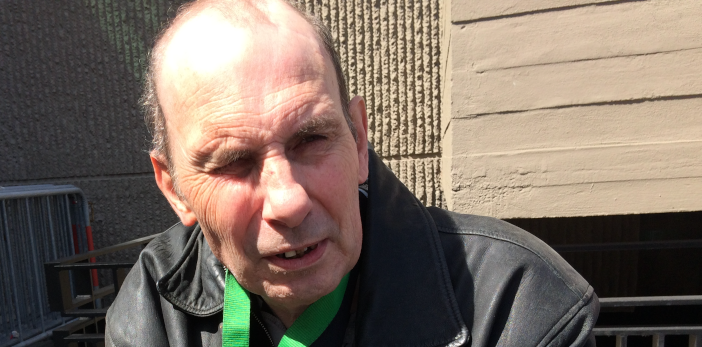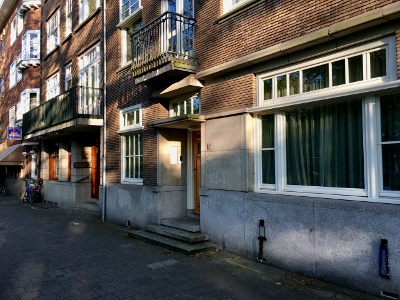
The book ‘The Man Who Had to Die’ is the story of a wealthy criminal who ended up in a wheelchair, severely disabled after an assassination attempt, and lost all his money. Ronald van Essen was one of the first ecstasy producers in the world. He earned tens of millions and had to pay for a failed assassination attempt. Such a book title raises the question: who wanted Van Essen to die? The answer in the book is clear and obvious: Van Essen’s former friend and real estate dealer Wim Endstra was the evil genius.
By @Wim van de Pol
Writer Julian Pater gained the trust of Van Essen, and of Peter R. de Vries, who assisted Van Essen after the assassination attempt. In the book, Pater relies, among other things, on lengthy conversations with Van Essen, who is missing part of his brain function due to his injury. Other sources include Van Essen’s wife and a childhood friend, who grew up with him in crime.
Van Essen has been severely disabled since 1999 after a failed assassination attempt. In 2018, his attempts to obtain money through the courts from Wim Endstra (who was shot dead in 2004) failed. He says he is owed tens of millions from the Endstra heirs.
The book presents Van Essen’s entire story for the first time. That account contains a number of remarkable and new details.
Flower power scene
Ronald van Essen (1953) was a working-class boy from the Amsterdam Pijp who decided to leave secondary school at the age of 17. Lugging crates at the supermarket isn’t to his liking either. During his first real job, at a textile company, he chooses to steal a van and use it to remove the inventory of expensive fabrics. So it becomes stealing, breaking and entering, a youth institution, the flower power scene and ultimately the hashish trade around Leidseplein. Van Essen is economical and businesslike and does not use hard drugs, he is extremely suitable for the drug trade.
Through a group of Danish tourists, the plan arises to transport hashish to Denmark. And his wife Gaby took him to a friend in Zandvoort in 1983.
Maybe she shouldn’t have done that.
Mustache and beard
The friend lives in a garden house in Zandvoort near the spacious home of a certain Wim Endstra. The Endstra family is wealthy. After Endstra’s grandfather collaborated profitably with the Germans in the Second World War, his trading company entered the freight transport business. The family became very rich with the Armita railway wagons.
Grandson Wim was the same age as Van Essen. He wore a mustache and a beard and drove his three children around Zandvoort in an old Opel. Wim no longer had to do it for the money. Yet Endstra was already as deeply involved in the hash trade as Van Essen.
Endstra loved sailing and operated a shuttle service to England with his sailboat. In a hidden room he loaded hash on the way there and money on the way back.
Rommy
Wim Endstra introduces Van Essen to exchange offices in the center of Amsterdam, which at that time still accepted hundreds of thousands in drug money without asking questions.
Van Essen’s hash trade is becoming increasingly large-scale. Together with Henk Rommy he imports large consignments of trucks from Morocco.
At one point, Van Essen “buys” Rommy free from a Moroccan cell.
Convoy Vastgoed BV
The business connection between Van Essen and Endstra starts at the end of the eighties. Endstra transfers a villa in Marbella, which was previously owned by an anonymous Van Essen company in Gibraltar, into his name. In 1987, Endstra founded his infamous Convoy Vastgoed BV. Van Essen claims that he came up with the name as a reference to the trucks with hashish that always drove in convoys of three from Morocco to the Netherlands.
According to him, Endstra then started investing his drug money. Van Essen’s important statement: Convoy Vastgoed would in fact have largely belonged to him and Endstra from that time on.
30 million
At the end of the eighties, Van Essen and his Rotterdam acquaintance Ton van Dalen started producing ecstasy. In the years 1990-1992, their pills (eg the famous “duifjes”) flooded the market in the Netherlands, Belgium and the United Kingdom. The “first spin” of those pills meant a profit of more than 100 million guilders.
The FIOD subsequently concluded that Wim Endstra had a role in laundering that ecstasy money. In 1992, the police shut down “the ecstasy gang”, Endstra got away with a transaction, Van Essen went to jail for years.
Endstra’s fortune grew to more than 300 million euros in the 1990s, partly due to his own brilliant way of doing business.
But how much was Ronald van Essen’s share in that fortune? At least 30 million euros, Van Essen estimates.
Substantiation

Julian Pater’s book contains a substantiation of that claim, which is based on fairly detailed notes that Van Essen made on a computer in prison. The police confiscated those floppy disks when Van Essen became a suspect in a new drug investigation.
Pater writes that Van Essen invested in real estate at Endstra via Convoy. On the other hand, money went to trust funds hidden away by Endstra in Liechtenstein.
Klepper and Mieremet
Not long after his release, at Christmas 1999, Van Essen was shot from behind as he sat in his car in front of his house on Minervalaan in Amsterdam. That attack was never solved.
The book Holleeders Onderwereld describes how the files in the Holleeder trial show that the police had a good idea of who the clients were. Heineken kidnapper Cor van Hout was one of the witnesses who identified Wim Endstra as the client a few days after the attack. The infamous criminals Sam Klepper and John Mieremet came into the picture as the people who had plotted the murder.
California Properties
These two had placed money with Endstra and were exerting pressure to gain control over Endstra’s assets. A few days before the assassination attempt, John Mieremet, through his wife’s private limited company, obtained shares for a bargain in a gigantic package of real estate from California Properties, a private limited company of Endstra.
The book reinforces that image, and highlights an animosity and rivalry that has not previously been published. Serious problems had arisen between Van Essen and Klepper and Mieremet since 1989.
Admiral de Ruijterweg
In 1989 there was a shooting at a notorious café on the corner of Admiraal de Ruijterweg in Amsterdam-West. Van Essen had been the owner there since 1988. It appears to have been a failed assassination attempt on the two “Yugoslavs” Milos “Bato” Petrovic and “Mikas” Vukmirovic. The two are considered part of the group of drug trafficker Klaas Bruinsma and more specifically his associates Klepper and Mieremet.
Pistol
Numerous complications then lead to a heated conflict between Klepper and Mieremet, the Yugoslavs, and Van Essen, and an extortion. At one point, Van Essen is placed on a chair in the cafe while a gun is fired next to his head.
Van Essen does not pay the “fine” of 1 million guilders. The café is forcibly sold to John Mieremet.
Peter R. de Vries
In 1999, the police suspected that the Yugoslavs and Klepper and Mieremet were behind the assassination attempt on Van Essen. “Bato” Petrovic was prosecuted, but was acquitted (in 2012) due to lack of evidence.
The police also suspected that Endstra, together with Klepper and Mieremet, wanted to get rid of Van Essen’s financial claim by having him shot.
Peter R. de Vries was also convinced of this, as he said as a witness in the murder trial against Willem Holleeder. Endstra is even said to have been involved in the liquidation of several people. A cousin of Endstra told investigators that Willem Endstra ‘financed’ liquidations. A report by Van Essen against Wim Endstra’s brother yielded no results.
Victim
In the criminal trials against Holleeder and the Passage trial, Endstra was mainly portrayed by the Public Prosecution Service as a victim of extortion.
How much of Endstra’s 300 million euros was left in 2004 is anyone’s guess. The Endstra heirs reached a settlement with the Public Prosecution Service for 40 million euros in 2015. This prevented the Endstra companies from being prosecuted for money laundering and tax evasion (and from being picked up through a confiscation case).
The Endstra heirs deny that they owe money to Ronald van Essen, and that seems to be the last word for now.
See previous stories about Ronald van Essen’s claim:
How the Public Prosecution Service never prosecuted Willem Endstra (#4 VIDEO)
Claim from the heirs of Willem Endstra (#3)
The attack on Ronald van Essen (#2)
Friendship, millions, assassination attempt (#1)
Why wasn’t Doctor XTC’s death solved? (UPDATE)




